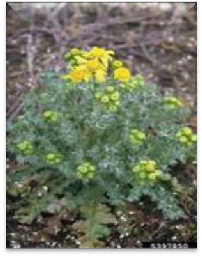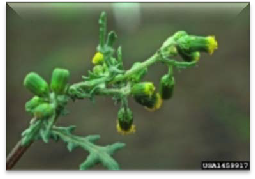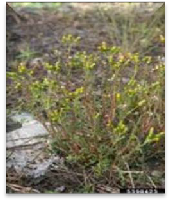Also Known As: old-man-of-the-spring
Common Groundsel is a Class C Noxious Weed: Non-native plants that are already widespread in Washington State – Counties can choose to enforce control, or they can educate residents about controlling these noxious weeds.
Common Groundsel (Senecio vulgaris L.) of Mediterranean origin is an annual or biennial with a taproot and fibrous root system; stems of the plant sometimes root at lower nodes. The plant is mostly hairless and its stem is hollow, branched and grows erect, usually standing 6-12 inches tall but capable of reaching heights of 2 feet. Basal leaves are stalked, somewhat  fleshy and have purplish undersides. The stem leaves are oblong and alternately arranged; while first leaves are barely toothed, later leaves are deeply lobed and coarsely toothed. The plant usually flowers from early spring to fall, but can flower year-round in mild climates. Flower heads occur in clusters at stem ends; the clusters are surrounded by green bracts with conspicuous black tips that distinguish groundsel from other weeds in the same family (Asteraceae) that includes the dandelion, sunflower and thistles. Individual groundsel flowers are yellow, tubular and often nodding.
fleshy and have purplish undersides. The stem leaves are oblong and alternately arranged; while first leaves are barely toothed, later leaves are deeply lobed and coarsely toothed. The plant usually flowers from early spring to fall, but can flower year-round in mild climates. Flower heads occur in clusters at stem ends; the clusters are surrounded by green bracts with conspicuous black tips that distinguish groundsel from other weeds in the same family (Asteraceae) that includes the dandelion, sunflower and thistles. Individual groundsel flowers are yellow, tubular and often nodding.
Common groundsel reproduces by seed only and is a prolific seed producer. Germination can occur in a wide range of temperatures, from early spring through late fall. Seeds are produced within several weeks of germination, and there can be several generations in the same year. The seed head is a white “puff-ball” similar to that of a dandelion; the seeds are tan, spindle-shaped and have dandelion-like “parachutes” that aid in wind dispersal.
Common groundsel grows best in cool, moist environments and fertile soils. This plant is often found in well-irrigated areas and in disturbed areas, such as cultivated fields, roadsides and waste areas.
Common groundsel contains alkaloids that are poisonous to livestock—cattle and horses in particular—causing cumulative, irreversible liver damage. Livestock losses are rare, however, and most poisonings are due to ingestion of contaminated hay over a period of time. Common groundsel is also an alternate host for a number of viruses, nematodes, and aphids.
Control Methods
Because common groundsel produces so many seeds, it is important that control efforts be made before seed set to prevent the infestation from spreading by seed. Seeds from open flowers can still mature and germinate even after a common groundsel plant is killed, so if there is any evidence of flowering, all parts of the plant should be bagged and destroyed.
Cultural: A healthy and vigorous plant community can inhibit the growth of common groundsel. Laying a 3-inch layer of medium-sized mulch can prevent seedling growth.
Physical/Mechanical: Common groundsel plants can be easily pulled by hand from moist soil. A hoe can also be used to cut the plant off with its taproot—which is necessary to prevent regrowth from the crown and root buds. Tillage, rototilling and mowing with a low-set blade can also be effective ways to destroy young plants.
Chemical: Several effective herbicides (e.g., those containing diquat, eptam, clopyralid or glyphosate) are available, but herbicide resistance has been a problem that may be avoided by switching the herbicide every few years to one having a different mode of action. Common groundsel is resistant to group 5 and 6 herbicides.
More information can be found in the PNW Weed Management Handbook
Use pesticides with care. Apply them only to plants, animals, or sites listed on the label. When mixing and applying pesticides, follow all label precautions to protect yourself and others around you. It is a violation of the law to disregard label directions. Store pesticides in their original containers and keep them out of the reach of children, pets, and livestock.
Biological: Larvae of the cinnabar moth (Tyria jacobaeae) will eat groundsel, but has not proven effective. A more promising control agent is the rust fungus Puccinia lagenophorae.
Questions: contact Steve Van Vleet or phone (509) 397 – 6290
Photo credits included in pdf





